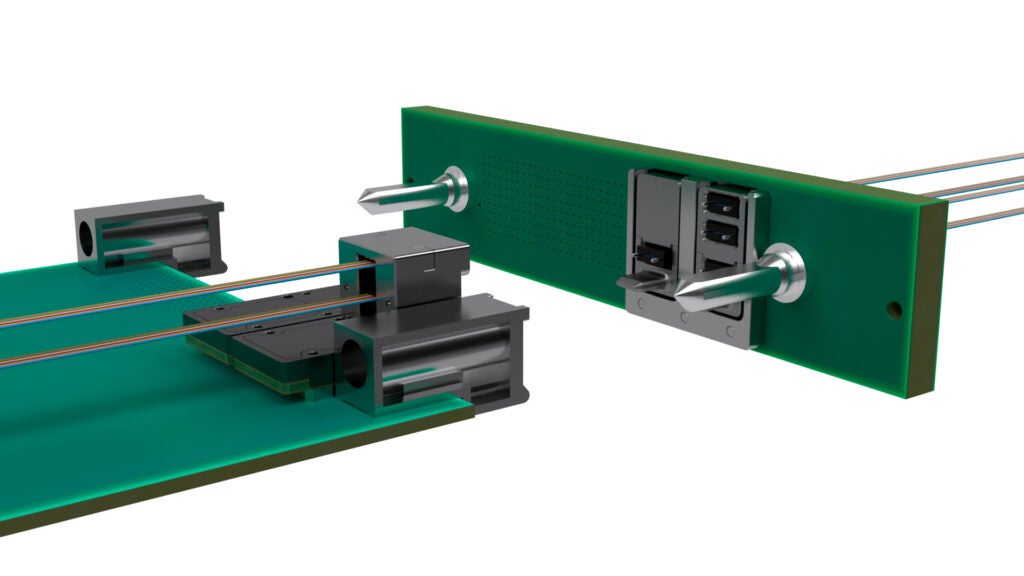
Optical interconnectivity has had a significant impact on the defense industry. Not only does it allow greater amounts of data to be passed over longer distances, but it also minimizes SWaP (size, weight, and power) relative to copper alternatives. In fact, cabling weight can be reduced by more than 90% and carry high-speed data 15 to 20 times further, which is especially beneficial for airborne systems.
Copper VPX connectors used for backplanes have been around for a long time, and although they offer a lot of throughput in a relatively small area, it comes at the cost of high power consumption and potential interference issues. For applications involving the highest-end processor boards, optical connectivity is a must.
Any applications in Command, Control, Communications, Computers (C4) Intelligence, Surveillance and Reconnaissance (ISR) that require more processing at faster speeds is a candidate for optical interconnectivity. VPX systems, including single board computers, FPGA and multicore processing boards for sensing and video, and 100G+ Ethernet switch cards will all benefit from the move to optical interconnects.
Looking forward, this trend is expected to continue given the rapid growth of AI and machine learning and the processing power that this technology requires.
To provide the defense industry with interconnectivity solutions that meet its developing demands, Smiths Interconnect offers its LightABLE® 28 family of mid-board transceivers, transmitters, and receivers that operate at up to 28 Gbps per lane or channel. These modules can be easily integrated into a customer’s system with electrical interposer connections (eliminating the need for solder processes or sockets) and detachable fiber pigtails for procurement flexibility, improved assembly processes and lower cost rework if the fiber is damaged.
In February this year, Smiths Interconnect launched the LightCONEX® family of optical interconnects that are compliant with the forthcoming VITA 66.5 standard, which will enable the next generation of OpenVPX systems.

According to Jon Lundberg, Product Line Manager for Defense & Avionics Fiber Optics at Smiths Interconnect: “The LightConex family was developed in response to the work of the new VITA 66.5 standard. The idea was to take the next step from just having passive optical interconnects on the backplane, which had been specified in previous standards, to integrating the transceiver itself as part of the backplane connector system.
“That takes the 10 and 28 gigabits per second optical transceivers off the mid-board area and integrates them into the connector in the back. That frees up board space and gives the customer more room to do other things, be it a bigger processing chip or the addition of more functionality.”
The use of LightCONEX can enable up to 1.4 Tbps full-duplex in a VITA full-width for maximum volumetric data density. Standards like VITA 66.5 and SOSATM allow for modular, interoperable, and easily upgradeable systems that offer higher throughput, minimize maintenance requirements and enable a robust supplier ecosystem. In the past, you had to adopt a new platform when looking to upgrade, now you’ll be able to just swap out cards.
Product Marketing Director Arlen Martin adds: “A key part of what makes the LightCONEX optical interconnect different is the ability to blind-mate in a VPX application. The optical MT connectors must align to less than five microns to minimize optical loss.
“Because of the very tight alignment requirement for the optical transceivers, VITA 66.5 added alignment features to the interconnects for a total of three alignment stages in the blindmate system. First, there’s the alignment of the VPX plugin card to the system backplane, then the VITA 66.5 optical interconnect alignment features engage, and finally the alignment pins of the optical MT ferrules. Designing a precise and robust optical alignment system was challenging, but the highest density version (Style D) has passed 500 mating cycle testing.”
For more information about the LightCONEX product range, download the brochure below.


